Katakana - syllable alphabet (each character does not mean sound, but a syllable) used in Japanese. It is part of a modern Japanese language. It includes 46 characters (and somewhat outdated). Catakan is used mainly to record borrowed words and interjections. Under the borrowed words means all the foreign words, names and names. Having studied Katakan, you can read most signs at stores, menu in restaurants, character names, online pages and inscriptions on Japanese disks. In fact, in most cases, English words are written to the cataka, that is, something like recording Russian words by translite ( vI PONIMAETE, CHTO YA IMEU V VIDY ^ _ ^), and therefore with sufficient knowledge of the English language you will understand what we are talking about.
In Katakan, each character (except for vowels and one exception) means not a letter, but a syllable - that is, a combination of consonant and vowel sounds. Just characters denoting consonant letters in the catakane. Each syllable has its own pronunciation, which never changes, regardless of the position of the syllable in the word or near the syllables, which is very convenient for memorization. True, there are composite sounds consisting of several syllables, but they are also always pronounced equally.
The entire set of sounds is based on "soft" consonants (T, K, C, X). Their "solid" analogues are obtained by adding to the original two drops ( nigori.) In the upper right corner of the icon. (If you do not understand, do not be afraid, understand in the course). Now that the structure of the language (catakana) has become a little clear, we turn to practical examples. I will write the Japanese writing of the syllable, the official writing of the syllable (in Romadzi), in brackets - alternative optionIf it is (in the Hepburna system), and through a slanting line - Russian transcription (in the polyvanov system).
Group of vowels
A / A - Normal Short Open "A"
\u003d I / and - the usual short open "and"
\u003d u / y - the usual short open "y"
\u003d E / E - Normal Short Open "E"
\u003d O / O - Normal Short Open "O"
Group of vowel derivatives
Ya / Ya
\u003d YU / Yu
\u003d yo / y
These derivatives (composite) vowel syllables are used not only by themselves for the transmission of sound, but also in the phrase formation, as additional parts of the syllable to explain its pronunciation (see below).
Agreement-exception
N / H - nasal phrasening "H". It is not softened by subsequent vowels, which in transcription is transmitted as "n".
Group of consonants "K,"
KA / KA
\u003d Ki / ki
\u003d KU / ku
\u003d KE / KE
\u003d KO / ko
GA / G.
\u003d gi / gi
\u003d GU / GU
\u003d GE / GE
\u003d go / go
Group of consonants "T-D"
TA / TA
\u003d Ti (Chi) / Ti
\u003d TU (TSU) / CSU
\u003d TE / TE
\u003d to / then
Da / Yes
\u003d di / di
\u003d DU / Du
\u003d DE / DE
\u003d Do / before
Group of consonants "S-Z"
SA / SA
\u003d Si (SHI) / si
\u003d SU / SU
\u003d SE / SE
\u003d SO / with
ZA / DZA
\u003d zi (ji) / ji
\u003d zu / dz
\u003d ZE / Dze
\u003d Zo / Dzo
Group of consonants "x-bd"
Ha / ha
\u003d Hi / Hee
\u003d Hu (FU) / Hu - the Japanese do not distinguish "Hu" and "Fu"
\u003d He / HE
\u003d HO / ho
BA / BA - sometimes used as "va"
\u003d Bi / bi
\u003d BU / bu
\u003d BE / BE
\u003d bo / bo
PA / PA
\u003d pi / pi
\u003d PU / PU
\u003d PE / PE
\u003d PO /
As you can see, the Japanese liked the letter "x" that they decided to form from it not alone, but as many as two "solid" sound! ^ _ ^ The sound "b" is marked with the usual dashes, and "P" - a circle ( hannigori.).
Group consonant "H"
Na / on
\u003d Ni / nor
\u003d nu / well
\u003d NE / NE
\u003d no / but
The group of consonant "M"
MA / Ma.
\u003d mi / mi
\u003d Mu / mu
\u003d ME / ME
\u003d Mo / Mo
Group consonant "P"
RA / RA
\u003d ri / ri
\u003d RU / ru
\u003d RE / RE
\u003d ro / ro
Note: The Japanese do not distinguish the sounds of "p" and "l".
Group consonant "in"
It's all! The set of letters "in" is not complete. Previously, the "VA", "VE", "WE", etc., was really present in it, but they came out of modern use due to a change in the laying.
Special sign
Own pronunciation does not have
In Japanese, there is a special symbol, denoting the doubling of the initial consonant following the syllable behind it. You noticed, it looks like a reduced catakana "TU / CSU", but does not have its own pronunciation (like our soft or solid sign). His goal is to focus on pronunciation of initial consonant in any syllable. In fact, his presence in the Word shows that the initial consonant of the syllable following him should be pronounced twice, that is, for example, the syllable "that" will turn into "T-then". As part of the word it will look like: "Lo" \u003d\u003e "Lo-T,". Agree, the second option sounds much better and more like pronunciation into the Russian version. Here is an example:
Congratulations! You have completed the study of the catakana! It was the last symbol. True, there are still a few subtleties, which I will tell below.
Examples of writing words
Now, when (if) you remember writing and pronunciation of all characters, I will give a few examples of writing simple words. Of course, some nuances not explained by me remained, but I will do it later.

With English words, everything is the same. Yes, by the way, if you are surprised why I wrote a catakane syllable "RU" and "RA", and translated them as "Lou" and "La", then read on. If you did not notice this, then you should again re-read the text above and understand the symbol writing.
Pronunciation of "long" vowels
When the Japanese seems that some syllable or vowel is pronounced for a long time, that is, longer than its "classic" pronunciation, they mark it in the records of the catakana, putting a long horizontal line (as our dash) after a syllable or vowel. In fact, it is possible to figure out when the sound lasts long enough to mark this feature, it is extremely difficult (I never happen), so this moment is important for reading text. To determine the same when it is almost impossible to put the line in the record, since the views of the Russians, the British and the Japanese about the longitude of sounds are greatly different. Here is a more or less obvious example, this time, for a variety, in English.
Note: An almost accurate feature of the "long" sound is a doubling of vowels. Almost certainly, instead of doubled vowel in the record, you need to put a dash - a sign of longitude.
The problem is "identical" sounds. "R - L", "X - F"
The fact is that due to the features of his language, the Japanese do not distinguish some sounds that are the same for them equally. (Nothing funny! And you will earn the difference in pronunciation between "Two", "Too" and "to"?) This feature refers to "b-in", "ji-ji", "sif-si", etc. d., but more visible in the sounds of "R-L" and "X-F". Therefore, to reproduce the sound "L", a number of letters "P" are used, and for the sound "F" - a number of letters "x". However, not everyone was satisfied with this system, so it was accepted new form Record using several syllables combined. Now for sound "f" such writing is used:
FA / F.
\u003d fi / fi
\u003d FU / Fu - He "HU / HU"
\u003d Fe / FE
\u003d FO / FO
As you can see, the basic syllable "Hu" is used. Agreed that if you add a vowel to it, it will designate a syllable with the letter "F". The vowel used to form a new syllable is written by a smaller font to show it. However, some lazy to decrease something there, so do not be surprised if you see a vowel large (as a syllable) of size, it is in order of things.
Fully exhausted by such a grand reform of the language, the Ministry of Education of Japan decided not to touch the sound "p", so get used to using the sound "p" instead of "l", it is not so scary, or change the keyboard layout. ^ _ ^
Here, for example, it looks like Final Fantasy, recorded by a catakana:
The formation of the sounds of the group consonant "in"
You probably torments the question: if there is only Katakana "VA", how do other syllables are formed with the letter "in", for example, "in" or "VE"? Or do they not exist at all? By the way, in Japanese, they really, that ... do not exist (or rather do not differ from the sound "b"), but are still present to record foreign words (as in the case of the sound "f"). There is no uniform in formation system here, but almost the official option looks like this:
WA / V.
\u003d wi / vi
\u003d Wu / W - He "U / U"
\u003d WE / WE
\u003d WO / in
Note: Sometimes you can meet the old, not used in modern speech, writing these syllables, which I will now give as information note so that you are not surprised if you meet somewhere in the text.
Wi / V - not used
\u003d WE / WE - not used
\u003d WO / in - not used
I continue to ship further, for with the sound of "in" the situation is far as difficult, since in English two sounds "in" - this is "w" and "v", which differ in each other, so there is also an entry for the sounds of the group in Katakan "V". These syllables are also based on the vowel "y", but nigori is added to them, since the sound "V" is harder. Further, the forming vowel (small size) is added, and we get a ready-made syllable.
VA / V.
\u003d VI / VI
\u003d VU / W
\u003d VE / WE
\u003d VO / in
Note: Instead of a "VA / VA" syllable, the syllable of "BA / BA" can be free, because in Japanese, the difference between them could not distinguish between them (and there is no).
For Russians, all these syllables with "in" sound almost the same, so the choice of the form of recording plays the role only when writing english words. Although, in my opinion, to record Russian words more competently use the group "w", as it is more consistent with the pronunciation of Russian "B", and Japanese too.
TOTAL: If you all understood with the letter "in" and its syllables, then you really understand Japanese and english! Although, in fact, everything is not so difficult, because the syllables differ from "WA / VA" are used extremely rare. Here you just need to remember that there is a sound catakana "WA / VA", and all other syllables with "in" are built on the basis of "in" the addition of relevant vowels.
Derived crossing
If there are vowel derivatives, then there must be some derivatives of the syllables where these vowels are used. If you think this is the way you are absolutely right. The rules for their education are very simple. Any basic syllable is taken - "consonant_su_no_" and "", after which the syllable is written a reduced "I", "Yu" or "E". We get a new syllable - "consonant_c_pronomy), i.e. When pronuncified, the old sound "and" is discarded, and the derivative of the voice is pronounced instead. I will bring not all possible syllables, but the principle you must understand. Here's what it looks like:

Note: Sometimes the vowel derivatives write the same size as all other syllables. In this case, if it stands after a syllable ending on the sound "and" (on the sound, and not to the catakana "and"!), We still have a deal with a derivative syllable. And if it stands after any other syllable, except for "consonant + and", then he sounds in itself.
Links
http://www.komi.com/japanese/ - Japanese Tutorial, Online Japanese Language Training, Lessons, Many examples and other necessary information
http://www.rinet.ru/~vit/ - "Vitaly Zagrebelnoe" page, an excellent Russian source, many references to a variety of useful resources in language, FAQ
http://www.charm.net/~Tomokoy/japaneselesson.html - "Yamamoto Tomoko" page, training Catakan for 13 lessons, many examples, links to Japanese sites
http://www.csse.monash.edu.au/~jwb/japanese.shtml - "Jim Brin" page, a variety of projects, a lot of programs, a lot of links for Catakan training, Haragan and Kanji, dictionaries projects, etc. , Links to Literature on Japanese (for practice in language), Grammar, spelling, Japanese tutorials
The study of any foreign language must be started with Azov, which is in most cases the alphabet. There will be no exception and Japanese. However, unlike European languages, there are two alphabets in Japanese. Let's figure out why there are two and what function they perform.
General name for Japanese alphabet - ditch. There are two types of Cana: Haragan (平仮 名) and catakana (片 仮 名). Both alphabet are slug. This means that they are not from vowels and consonant sounds, but from signs that mean syllables (in Japanese they are called mora). For example, ま (mA), く (ku), ふ (fu), カ (ka). The exception will be a sound that looks more like an English nasal sound [n], and sometimes pronounced as "M", depending on the syllables that face it. Denotes in the system of the Haragans ん, cataakans ン.
And Haragan, and Catakana originated from hieroglyphs (Japanese kanzi.) who were borrowed from China and adapted under japanese pronunciation, Therefore, kana signs, like hieroglyphs, it is necessary to write in a strict sequence of damn.
Why do you need Japanese alphabet signs?
Japanese letters: Haragan

Initially, this kind of canova was considered a female letter as a lightweight version of writing. But, despite this, many great works were written by Haragan, for example, Genji Montogatari.
Imagine that the hieroglyph in Japanese is similar to the Russian keyword, which does not change. In Russian, when speaking, we inclined, hide and produce other manipulations with words with the help of the attachment of various suffixes, endings and consoles. This is the role of the word of the elements and is playing Haragan.
Take, for example, the word 食べる (Taber) means "there is, to eat." In it, it is a hieroglyph, and べ and る - the signs of the Haragan. What happens if we decide with you this word somehow modify? It turns out about the following: 食べ ます (I will eat), 食べ ましょ う (come on), 食べる な (do not eat!). We see that the hieroglyph is both and remains on the spot, and the signs of the Haragans are changing. So, these changing signs are called okurigan And help to decline / hide / modify Japanese words.
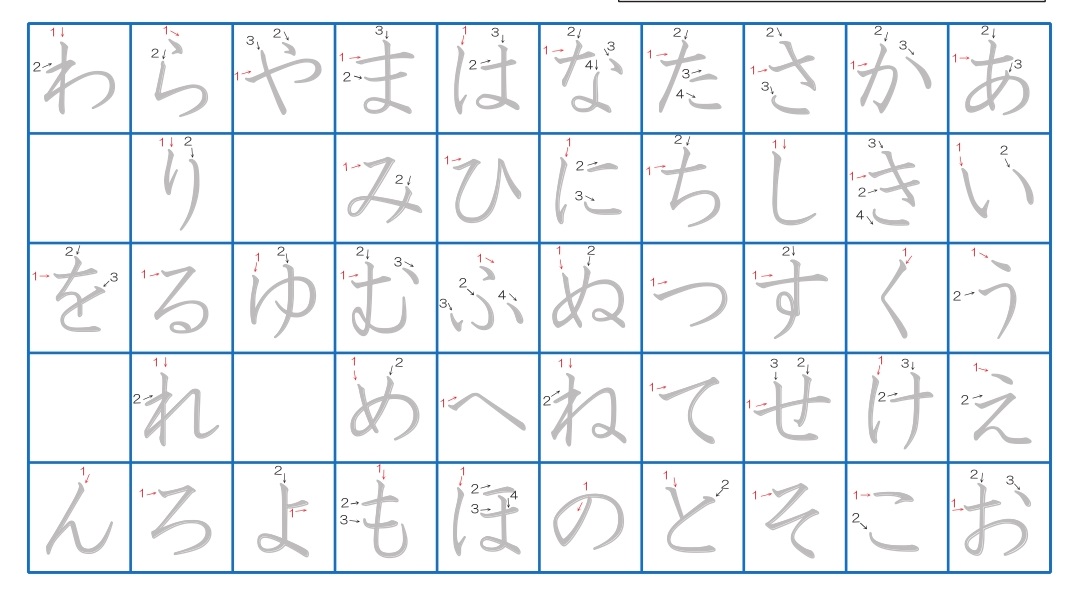
The following Haragan function is to decipher the kanji. If you ever see the little charagana badges above or under hieroglyphs in the text, know that these are signs furigans And are designed to help in reading unfamiliar hieroglyphs, that is, Furigan is a kind of transcription.
Also, this Japanese alphabet is used when writing words that do not have hieroglyphs, grammatical particles (まで, に) and some adverbs.
Texts are written for chiragana elementary schoolWhen children know still few hieroglyphs. But the perception of such a text for studying the Japanese is complicated by the fact that there are no spaces in Japanese, and the commas, in fact, can be put anywhere.
Basic set of canova signs is called godjuonThe additional signs are formed from it. This is done using special characters:
- ゛- nigori. Sounds signs. For example, た (ta) when attaching nigori turns into だ (yes);
- ゜- maru. It is used only in one row on は (ha) and turns "x" in "P". For example, は (ha) in ぱ (Pa), へ (HE) in ぺ (PE), etc.;
- っ Recognizes the doubling of the previous syllable. っ て (TTE), っさ (ssa), etc.;
- small letters ゃ (I), ょ (E), ゅ (U) are used to mitigate sounds. り (r) turns into りゃ (ry), し (s) in し ゅ (s).
To refer to the longitude of sound, use a small sound ぅ (y). When writing Japanese words by Russian letters to designate longitude, it is possible to either double the extended sound (ありがとう - Arigato), or mark it with a colon (Aritato :).
Japanese letters: Catakana
Although writing angular catakana seems simpler than smooth surgery, it is harder.
These angular Japanese letters are used when writing words of foreign origin or, if necessary, highlight some word in the text (just as we emphasize or allocate words in italics). Sometimes the catache writes animals or plants.
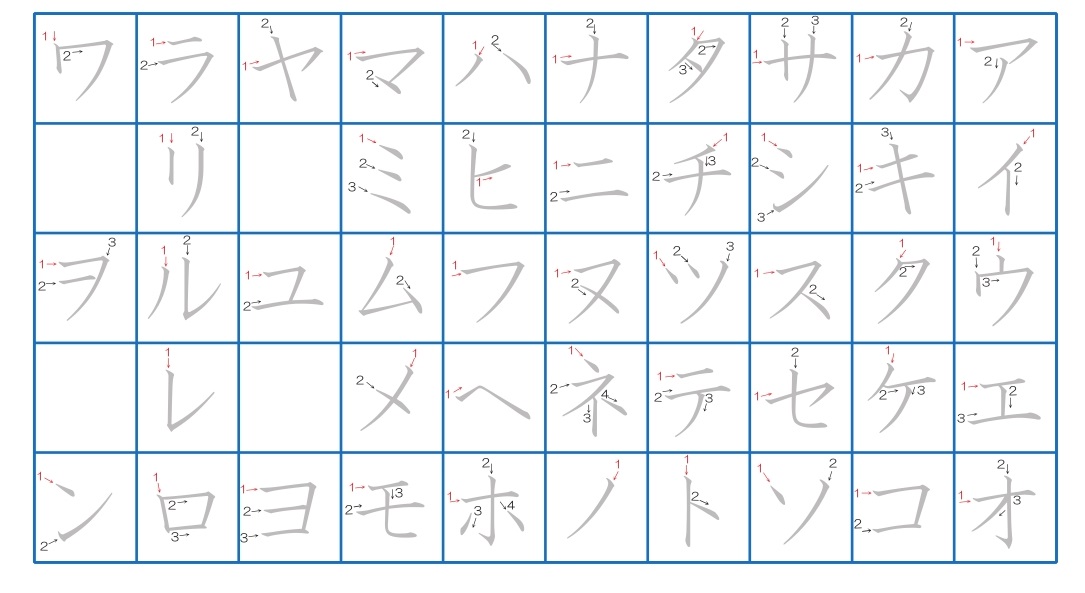
At first, Katakana was used as signs of ocurigans, but since 1946, it took shape as an independent view of Cana.
In Katakan, as well as in Haragan, there are additional signs formed not only with the help of the objects described above, but also in other ways:
- Due to the need to convey the phonetics of a foreign language, a merger of Mora + vowel, for example, ヂ (di) + ィ (and) \u003d ディ (ディスク - Disc) appeared.
- The longitude of sound in the catakane is denoted by a long feature ー, and doubling the sign ッ.
When transliterating foreign words to the Japanese, a number of features must be taken into account:
- In Japanese, there is no letter l, it is replaced by "P". Therefore, the Russian names of Jura and Julia will have almost the same.
- The Japanese do not distinguish "Fu" and "Hua", and there are difficulties if necessary, to distinguish "in" from "b" (for example, the Volga will sound like bo-ru-ha).
- You should also not forget that, due to the absence of separate consonant letters, there is a need to join the consonants of the vowels. Most often it is the sounds of "U" and "O". Tatiana's name will sound quite recognizable for the Russian ear - Ta-A-on, but the name Svetlana will acquire a new sound of Su-Ba-Tu-ra.
How to effectively learn Japanese alphabet?
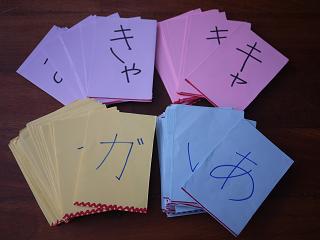
It is right to say that each beginning to explore Japanese can find its own way of best memorization. Below we will give the most common ways to memorize kana signs:
- Cards.
Cut the cardboard paper cards. On one side they write the sign itself, on the back russian pronunciation And, at will, the word starting to this mora. You can also attract a friend (optional to know Japanese). A friend calls Mora in Russian, and you find out among the cards you need and say the word.
- Substitution of syllables.
there is program Kananization, You can google it. It replaces syllables in the text to Japanese analogues. It is better to choose the "Snowball" mode, then it will occur gradually. Choose 25 pages of interesting Russian text for you and insert into this program. It will look like this:
There is a Yap お NSC お e belt.
SK あ ZKA, simpler gov お rod:
C お Breed い Sing OND あ Zhuda Zver い
Select い Rail with え Ba Tsar!This method is great for fastening signs after you write these signs. And you will be faster to read Japanese.
- Association.
This method will suit students with a rich imagination. To each sign it is necessary to come up with its own association, for example, あ (a) something like our Russian "A", し (SI) is a hook, う (y) - ear, etc. Who has enough fantasy on.
But no matter how much you take advantage of the way, one of the above or copyright, it is strongly recommended to start a notebook for training (or download cana punctacies on the Internet) and try to write as much as possible. And also, if possible, try to find texts written by Cana, and read them and perform exercises to work out signs.
Do you already know Japanese alphabets? How much time did you go to study them? And do you have your favorite techniques? If yes - share them in the comments!
Want to learn Haragan in just a week? Do you think it is impossible? But I'm telling you seriously? After a week you will begin to read and write on the Haragan. Do not believe? .
In modern Japanese, there are two sludge alphabets: Haragan and Catakana.
Japanese alphabet of Hiragana
Haragan is usually used in combination with hieroglyphs, where prefixes, suffixes and other grammatical elements, all sorts of particles, etc. are denoted. You can simply write a Japanese word on this alphabet in various situations. For example, some words are taken to write on this alphabet, and not by hieroglyphs, or as a transcription of hieroglyphs, etc.
For example, the expression "pleasant appetite" on japanese alphabet Haragan is written as follows: ![]() and pronounced ITADakimas
and pronounced ITADakimas
And this means on Japanese "Sorry" ![]() And read as "Sumimasan".
And read as "Sumimasan".
Japanese alphabet Katakana
Katakana is used to record foreign words, names, names and other things. Also, this alphabet is sometimes used to record Japanese words as italics to highlight the word.
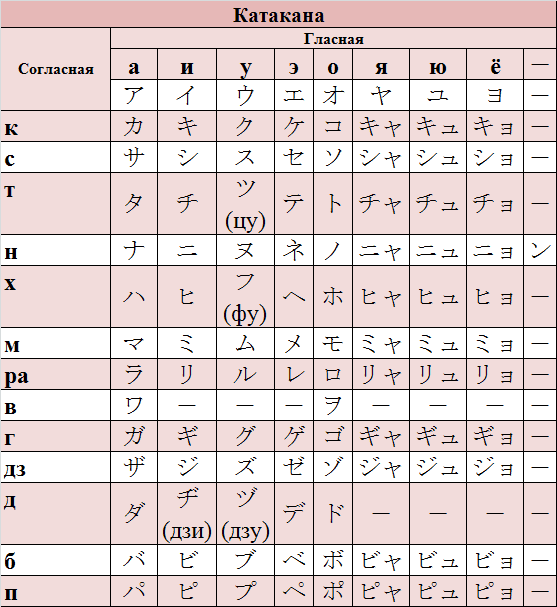
As you might notice in Japanese, there are no some letters. Therefore, to record words with missing letters, the closest to sound are used. For example, C \u003d w \u003d u, B \u003d b, s \u003d dz, l \u003d p, f \u003d x, etc. Also, except the letter N in the Japanese alphabet there are no consonants not included in the syllables. They are replaced with a syllable with the letter y, and since the syllables of that and do not, then they are applied to.
As an example, we will analyze how to write a name Maxim on Japanese: マクシーム
Ma \u003d マ, k \u003d ku \u003d ク, si \u003d シ, ー - sign of accepted, m \u003d mu \u003d ム and it turns out "Makusima"
The following example will write the name Victoria on Japanese: ビクトーリヤ
vi \u003d bi \u003d ビ, k \u003d ク, then \u003d ト, ー - the sign of the accent, Ri \u003d リ, I \u003d ヤ \u003d bikuoy
However, in the 20th century foreign words The Japanese Alphabet of Katakana was increasingly used and more used.

Now you can write the name Victoria not as a bikoute, but with new signs of Vicutory - ヴィクトーリヤ
And the name of Zina on Japanese is so ズィーナ, and not Dzin, as it was recorded earlier. ジーナ
You can write a name using any option, but the second more modern and better transmits a foreign name / word recording. By the way, it is used when transferring names on this site.
If you want to learn the Japanese alphabet, then the most effective is to read the texts on Japanese alphabets. It is still very good to learn Japanese alvafit on songs:
Song for memorizing Japanese ABC Haragan
Song for memorizing the Japanese ABC Catakana
So in the previous lesson, we made a feat, trying to figure out what.
And in this lesson, we will concentrate on Japanese alphabets - Catakana and Haragan, because it is with them we will learn to read Japanese.
2) Hiragana
Believe me, Haragan You will love the most and will be happy to read it (unlike the same catakana).
Haragan is a syllable alphabet, which is used to record Japanese words, endings, ligaments, particles, consoles and other things.
Table of Haragan with readings:
As you can see, the Haragan consists of vowels, one consonant n, and a different kind of syllables.
An example of recording words Hiragas:
わたし \u003d WATASHI \u003d I
ねこ \u003d Neko \u003d Cat
にほん \u003d Nihon \u003d Japan
What are these strange quotes and mugs over some characters of the Haragana?
(゛) - Nigori (or it is called Dakutane) - used for spilorous consonants.
For example:
た \u003d Ta, and with Nigori だ \u003d Da
き \u003d ki, and with nigori ぎ \u003d gi
こ \u003d Ko, and with nigori ご \u003d go
(゜) - ha-nigori (or handakuten) - replaces the syllables of some ha (ha, chi, fu, he, ho) on Pa, Pi, Pu, PE, respectively.
For example:
は \u003d HA, and with Ha Nigori ぱ \u003d PA
ふ \u003d FU, and with Ha Nigori ぷ \u003d PU
Here you can download the propisions of the Alphabet of Haragan and see the reading exercises of the Haragan:
3) Katakana
Catakana is considered a simplified syllable alphabet and it is used to record foreign borrowed words. But despite the fact that she is considered simplified, nobody loves her, and it is usually remembered more difficult than Haragan. Why? Most likely, because it meets in the texts it is less likely and therefore it has to use it, remember and repeat.
One way or another, here she is beautiful, Meet:
(Click on the picture to enlarge)
All the same syllables, all the same vowels, consonants, combinations, nigori and ha-nigori, as in Haragan. Therefore, it will be easier to memorize.
Once again I will remind you that you have a catakana to record foreign borrowed words, for example:
ケーキ - KE-KI from English Cake (Cake, Cake)
フォーク - FO-KU from English Fork (fork)
エレベータ - Erebe-Ta from English Elevator (Elevator)
A long trait in the words recorded by a catakana means lengthening vowels, long sound.
Here you can download the propisi of the ABC Catakana and see the exercises for reading Catakana:
___________________________________________________________
Convenient chamber of the chiragana and catakana together:
(Click on the picture to enlarge)
This lesson will be supplemented and fascinated by new links to additional materials on the topic of Katakana and Haragan.
In the following lessons, you will definitely be given exercises for reading catakans and hiragana, convenient registers and all sorts of different explanations 🙂
Greetings, you are expensive readers interested in the country of the rising sun and just wanting to master the Japanese! In this article, I want to talk about Japanese writing. Or rather, explain what the Haragan differs from Catakana and tell about the appointment, each of them, so that you feel easier to navigate in the use of both alphabet.
Four types of writing
So, for those who do not know, I will say that in Japan at the moment, three types of writing are used! This, two alphabets - "Hiragana" (ひらが な) and "Catakana" (カタカナ), as well as, well-known hieroglyphs - "Kanji". And if it is even more accurate, then among other things, officially common and "Romadzi" (Latin characters) is in writing the names of stations, pointers, etc. Often, this fact scares some of those who are going to learn Japanese on their own.
Of course, to master this language, even for the average level, the hieroglyphs will have to be pretty "sweat". By the way, the "list of everyday hieroglyphs," includes 1945 signs. Many true?! And here you can not walk, one cramp. In hieroglyphs there is logic, it is not just a set of sticks that differ only in their number or angle of inclination. " But if you understand these patterns, then remember japanese hieroglyphs It will be much easier.
And do not be afraid that the number of characters is quite large, everything will come with time, and on your part only persistence, desire, practice and discipline is needed. After all, you will agree - every foreign language takes time and hardworking. And it does not happen, unfortunately, so that I woke up the next morning, and began to understand a foreign language :).
As for the Haragan and Catakan, everything is different here. Both alphabets have absolutely the same sound and differ only, external species. Those. The letter "A" is read as well, in both alphabets. But visually, it will be somewhat different: "あ" (Haragan) and "ア" (catakana).
The same thing happens with the other letters. "KU" (く; ク), "va" (わ; ワ), "I" (や; ヤ).
For convenience, I made a table of the letters of the Japanese alphabet with the translation into Russian. Both alphabets are included in one common writing system, which is called the Japanese Kana alphabet. Thus, in the scheme, you can see the letters of the Hiragana - on the left side of the cell, and the catakans - respectively with the right:

Both alphabet consist of 46 major letters (here includes sludge and single). In addition, there are both, in both alphabets (about the next article).
Difference in destination
Now, I think you ask: "Why then, need Hiragana and Katakana? Why two, similar alphabet? " And everything is in that, each of them is endowed with its functions. So, consider it in more detail:
- Alphabet of Haragan, is used to write particles, variable parts of adjectives, verbs, and in some cases of the words, Japanese origin;
For example (ひらが な):
ねこ - "NEKO" CAT (猫)
さかな - "Sakana" Fish (魚)
さくら - "Sakura", Sakura Tree
こども - "Code" child, children (子 供)
の - "But" - an indicator of a genitive case (Pade Suffix)
青い - "Y", the end of the adjective in the Word (Aoi) blue
飛ぶ - "bu" - the end of the verb (TOBU) fly
- Catakana's alphabet, designed to write borrowed slobes of other languages \u200b\u200band foreign names of their own (Averest: Moscow, Italy, Volga, Everest or names and surnames: Catherine, Nikolai, Petrov, Sidorov, Bagration, etc.);
For example (カタカナ):
バナナ - "Banana" banana
ガラス - "Garasa" glass
フランス - "Furanus" France
クリスマス - "Kurisumasu"
プレゼント - "Publoseno" gift
ベロニカ - "Beronic" Veronica
シドロヴィッチ - Sidorobichi Sidorovich
アレクサンドル - "Arkusandor" Alexander
Those. All that is borrowed from foreign languages \u200b\u200band it does not matter that these are the objects of the wardrobe, the name of the dish, your name or location - will be recorded using カタカナ. As for the Japanese words, the same part of speech - then you will need ひらが な. 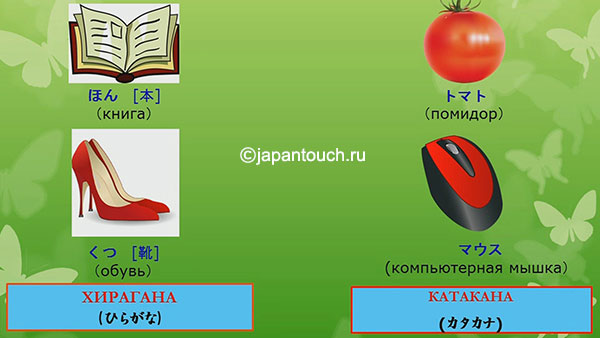
And I will add that in the Japanese alphabet, there is no sound "l", the sound "P" is used instead. The fact is that in Japanese, it is simply no. Although, sometimes in the speech of the Japanese, you can hear the dedicated sound "P", pronounced, more close to our "L". Sometimes it can be heard among young people. But on the text it will look only like "ら", "り", "る", "りゃ" and so on.
Look at my video tutorial: " Japanese language. Why do you need two alphabets, "where I tell about the differences between both alphabets.
Well, on this, I finish the current article, I think that you were interested, subscribe to new articles of my blog and consult a page to friends in social networks. All the best!




